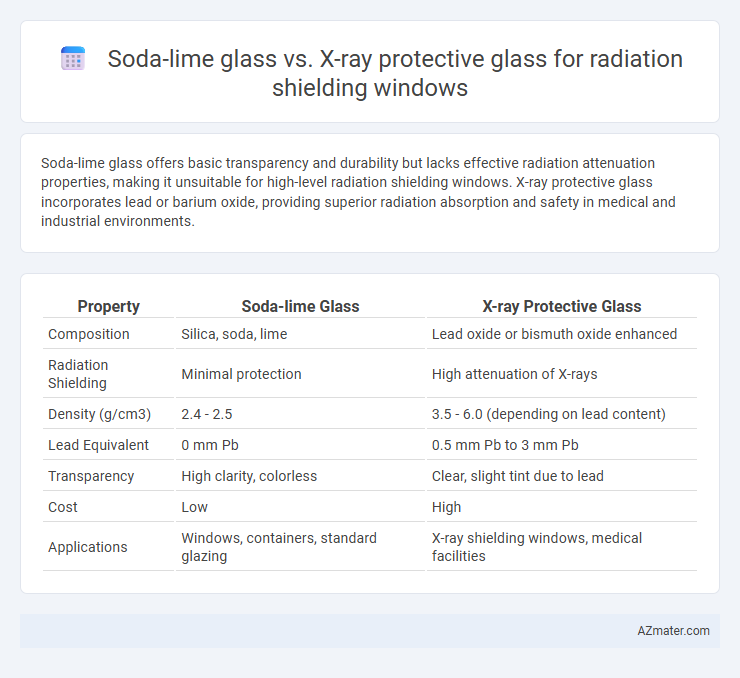Soda-lime glass offers basic transparency and durability but lacks effective radiation attenuation properties, making it unsuitable for high-level radiation shielding windows. X-ray protective glass incorporates lead or barium oxide, providing superior radiation absorption and safety in medical and industrial environments.
Table of Comparison
| Property | Soda-lime Glass | X-ray Protective Glass |
|---|---|---|
| Composition | Silica, soda, lime | Lead oxide or bismuth oxide enhanced |
| Radiation Shielding | Minimal protection | High attenuation of X-rays |
| Density (g/cm3) | 2.4 - 2.5 | 3.5 - 6.0 (depending on lead content) |
| Lead Equivalent | 0 mm Pb | 0.5 mm Pb to 3 mm Pb |
| Transparency | High clarity, colorless | Clear, slight tint due to lead |
| Cost | Low | High |
| Applications | Windows, containers, standard glazing | X-ray shielding windows, medical facilities |
Overview of Radiation Shielding Windows
Radiation shielding windows primarily use materials like soda-lime glass and specialized X-ray protective glass to block harmful ionizing radiation while maintaining visibility. Soda-lime glass offers basic transparency but lacks sufficient attenuation for high-energy radiation, whereas X-ray protective glass incorporates lead oxide or other heavy metal oxides, significantly enhancing its radiation absorption capabilities. These advanced glasses provide critical shielding in medical imaging and nuclear facilities, balancing safety requirements with optical clarity.
Composition and Properties of Soda-Lime Glass
Soda-lime glass primarily consists of approximately 70-74% silica (SiO2), 12-16% sodium oxide (Na2O), and 5-12% calcium oxide (CaO), which contribute to its affordability and ease of manufacture. This glass type exhibits relatively low density and refractive index, offering limited radiation shielding capabilities compared to specialized X-ray protective glass. Its mechanical properties include moderate hardness and brittleness, making it unsuitable for high-efficiency radiation attenuation in medical and industrial X-ray shielding applications.
Structure and Characteristics of X-ray Protective Glass
X-ray protective glass typically incorporates heavy metal oxides such as lead oxide or barium oxide, which significantly enhance its radiation attenuation properties compared to soda-lime glass. The structure of X-ray protective glass is dense and homogenous, specifically engineered to absorb high-energy X-rays while maintaining optical clarity. Its unique composition delivers superior shielding efficiency, making it essential for radiation protection windows in medical and industrial applications.
Radiation Shielding Mechanisms: How Each Glass Performs
Soda-lime glass primarily relies on its thickness to attenuate radiation, offering limited protection due to low density and atomic number, which results in less effective absorption of high-energy X-rays. X-ray protective glass incorporates heavy metal oxides like lead or bismuth, significantly enhancing attenuation by increasing the glass density and atomic number, thereby improving photoelectric absorption and Compton scattering. These intrinsic material differences allow X-ray protective glass to provide superior radiation shielding performance, making it essential for applications requiring stringent control of X-ray penetration.
Comparative Analysis of Lead Content and Safety
Soda-lime glass contains trace amounts of lead, typically less than 1%, offering minimal radiation shielding and lower protection against X-rays. X-ray protective glass incorporates significantly higher lead content, often ranging from 15% to 30%, enhancing its ability to absorb harmful radiation effectively. The increased lead concentration in X-ray protective glass ensures superior safety for environments requiring stringent radiation shielding, such as medical and industrial facilities.
Optical Clarity: Visibility in Radiology Environments
Soda-lime glass offers high optical clarity with excellent light transmission, making it suitable for general visibility but provides limited radiation shielding in radiology environments. X-ray protective glass contains lead or other heavy metal compounds, significantly enhancing radiation attenuation while maintaining comparable optical clarity to ensure clear visibility through shielding windows. The balance between radiation protection and transparency is critical, with X-ray protective glass optimized to prevent image distortion and preserve accurate visualization for diagnostic and interventional procedures.
Durability and Long-Term Performance
Soda-lime glass, commonly used for general applications, lacks the specialized composition to withstand prolonged radiation exposure, leading to potential degradation and reduced durability over time. X-ray protective glass contains heavy metal oxides like lead oxide, providing enhanced radiation shielding and maintaining structural integrity under continuous exposure. Long-term performance of X-ray protective glass surpasses soda-lime glass by resisting radiation-induced discoloration and preserving optical clarity, essential for reliable and safe radiation shielding windows.
Regulatory Standards and Compliance
Soda-lime glass, commonly used in windows, lacks sufficient attenuation properties for effective radiation shielding and typically does not meet stringent regulatory standards such as those specified by the Nuclear Regulatory Commission (NRC) or International Atomic Energy Agency (IAEA). X-ray protective glass, integrated with lead oxide or barium oxide, is engineered to comply with these regulations by providing required lead equivalency and absorbance levels to ensure safety in medical, industrial, and research environments. Compliance with standards like IEC 61331-1 and ASTM F2547 ensures that X-ray protective glass effectively minimizes radiation exposure while maintaining optical clarity for diagnostic and control room applications.
Cost and Availability Considerations
Soda-lime glass is widely available and cost-effective for radiation shielding windows but offers limited protection against X-rays compared to specialized X-ray protective glass, which contains heavy metal oxides like lead or barium for enhanced attenuation. X-ray protective glass is more expensive due to its complex manufacturing process and rare raw materials but provides superior radiation shielding essential for medical and industrial applications. Balancing cost and performance, soda-lime glass suits low-radiation environments, whereas X-ray protective glass is indispensable where stringent radiation safety standards are mandatory.
Choosing the Right Glass for Medical and Industrial Applications
Soda-lime glass offers cost-effective transparency but lacks the density required for effective radiation shielding in medical and industrial settings, making it unsuitable for windows exposed to X-rays. X-ray protective glass, often infused with lead or barium oxide, provides superior attenuation of ionizing radiation while maintaining optical clarity essential for monitoring environments. Selecting the right glass depends on balancing radiation protection levels, visibility needs, and regulatory compliance to ensure safety and functionality in controlled areas.

Infographic: Soda-lime glass vs X-ray protective glass for Radiation shielding window
 azmater.com
azmater.com